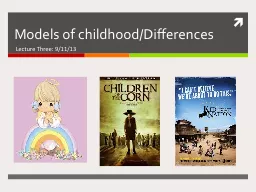/


Lecture Three 91113 Im not that innocent Childrens literature and culture are shaped by societys attitudes regarding childhood More than one attitude may prevail at any given time ID: 148760
Download Presentation The PPT/PDF document "Models of childhood/Differences" is the property of its rightful owner. Permission is granted to download and print the materials on this web site for personal, non-commercial use only, and to display it on your personal computer provided you do not modify the materials and that you retain all copyright notices contained in the materials. By downloading content from our website, you accept the terms of this agreement.
Slide1
Models of childhood/Differences
Lecture Three: 9/11/13Slide2
“I’m not that innocent…”
Children’s literature and culture are shaped by society’s attitudes regarding childhood.
More than one attitude may prevail at any given time.The transition from child star to adulthood is one of the narratives with which we are all familiar, for instance.Slide3
Models of Childhood
Model of Childhood
Brief description
The Romantic ChildThe association of children with innocence and purity
The Sinful Child
The notion of the child as sinful and in need of correction
The Working
Child
The reality
that many children had to provide for themselves and/or their families – the child as capable laborer
The Sacred Child
The idea that childhood
is a separate and sacred time and that children should be protected and coddled
The Child as Radically Other
The belief that children are fundamentally different than adults.
The Developing Child
The hypothesis that children develop on a continuum
in stages
The Child as Miniature Adult
In contrast to the child as Other,
this vision posits the child as independent and autonomous – an adult in miniature.Slide4
Case Study: Kid Nation
“For
40 days in April and May, CBS sent 40 children, ages 8-15, to a former ghost town in New Mexico to build a society from scratch. With no access to their parents, not even by telephone, the children set up their own government, laws and society in front of reality television cameras. The goal, according to creator Tom Forman (Extreme
Makeover: Home Edition and Armed and Famous
)
, was for
‘kids
to succeed where adults have failed
.’”
Source: Fernandez, Maria Elena.
"Is CBS
Reality Show 'Kid Nation’ Just Child's Play?” Los Angeles Times, August 28, 2007.Slide5
The Trailer Slide6
The childrenSlide7
The controversies
Based upon your viewing of the trailer, what models of childhood, as articulated by Hintz and
Tribunella, might be at work in potential reactions to Kid Nation?Do any of you remember watching this series? What was your reaction back then? Does it differ from your adult reaction?Slide8
Differences: Avoid Generalizations!Slide9
Challenges to Idealized Visions of Childhood
Child Crime
Child SexSlide10
A Long Way Gone
Whenever I teach Ismael
Beah’s A Long Way Gone: Memoirs of a Boy Soldier, I ask students to think about Beah’s challenge: he has to convince his readers that he was truly innocent before being forced into soldiering so that they can believe that he could be rehabilitated later. Understanding models of childhood AND understanding the different ways of being a child are central to how we interpret children’s texts.Slide11
Hintz and Tribunella
“Clarifying how we think about children and knowing about the history of childhood will help us to understand literature written for and about them” (32)
“Conversely, children’s literature can provide a way of tracing the history of childhood, since the kind of child it both implies and represents will be affected by the construction of children and childhood in the era of a literary work’s composition” (32).Slide12
Chapter Layout for
Reading Children’s Literature
Main chapter, separated into headings and sub-headings (good for outlining as you study)Reading Critically – enabling you to see how Hintz and Tribunella apply what they have just taught you to a work of children’s literature
Discussion and Essay QuestionsSuggested Activities and ReadingsApproaches to TeachingSlide13
Homework
Read Gaiman’s
CoralineComplete the Coraline handout
Be ready for a closed book quiz on Coraline